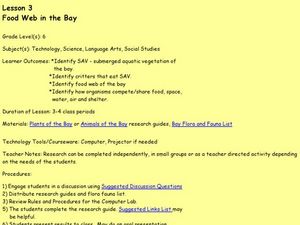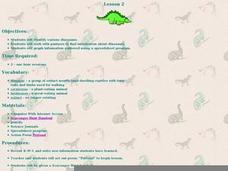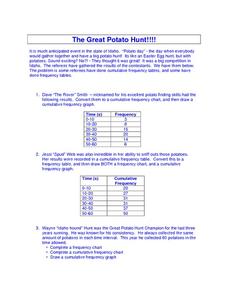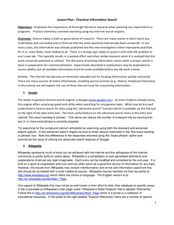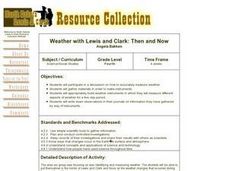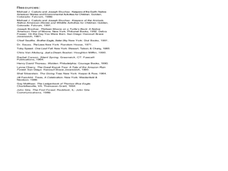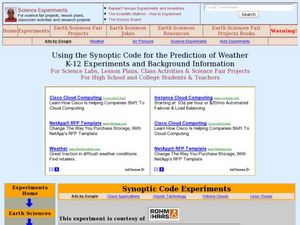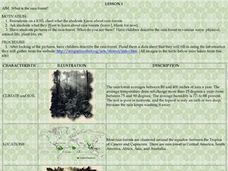Curated OER
Traditional Gardening in Alaska
Students research local history of agriculture using books, internet and local Elders. They conduct an interest survey for a community garden, using information gathered through interviews with Elders. A graphic organizer may be used to...
Curated OER
They Don't Just Eat Grass
Students explore and examine different types of feed used for livestock. They discuss types of feed, the need for energy and health, and create graphs of food compared to categories. Students organize data and complete worksheets on...
Curated OER
Water Down the Drain
Did you know that leaky faucets waste $10 million worth of water? Conservationists perform an experiment and draw best-fit lines to explore how the US Geological Society determined this value.
Teach Engineering
Start Networking!
Class members create their own social networks by collecting signatures before graphing the interactions with their fellow classmates. The degree distribution of the simulated social network is determined by calculating the degree of...
Curated OER
Food Web in the Bay
Sixth graders study the food web in a bay. In this food web lesson plan, 6th graders investigate the SAV- submerged aquatic vegetation of a bay including their predators, and how the organisms eat, have proper living space and water....
Curated OER
Being Responsible for Earth
Eighth graders explore the characteristics of responsibility. In this character lesson, 8th graders complete a self-evaluation. Students view a responsibility video. Students write a newspaper article on selected environmental issue.
Curated OER
Radiation and Color
Tenth graders explore the relationship between color and heat absorption by measuring the temperature change of water in differently colored test tubes as they are exposed to a heat lamp. They work in small groups to collect data and...
Curated OER
Microclimates of Our School
Students read the story "Weslandia" by Paul Fleischman, define the term microclimate, gather and record data in various places on school grounds to establish the presence of difference microclimates, analyze and compare microclimates,...
Curated OER
Acids and Bases: Their Reactions, Conductivity, Base Indicators and Neutralization Reaction
Students conduct experiments and collect data to determine physical and chemical characteristics of acids and bases.
Curated OER
Dinosaur Scavenger Hunt
Young scholars conduct research on dinosaurs and graph the information gathered using a spreadsheet program. In pairs they complete an Internet scavenger hunt, and record five facts about dinosaurs in their science journal.
Curated OER
Living in Extreme Environments: Havens on the Deep Sea Floor
Learners identify the characteristics of an extreme environment in the deep ocean and consider what organisms need to survive in these elements. They research sampling and data collection methods in this environment.
Curated OER
The Great Potato Hunt
For this science worksheet, learners examine the data from the potato hunt where potatoes are found like Easter Eggs. The data of the number of potatoes found is recorded in the frequency tables.
Curated OER
Chemical Information Search
Students research information using various internet resources. In this chemistry lesson, students demonstrate their ability to navigate websites and gather necessary information. They evaluate the potential usefulness of the databases...
Curated OER
(Clues to) Copying the Codes: Examining the Evidence
Young scholars view animations of DNA replication and transcription and complete a worksheet. In this genetics lesson, after watching on-line video clips to gather information about DNA replication and transcription, student teams...
Curated OER
Who Did It?
Students apply the concepts from forensic science lessons to do a lab. They solve a mystery using experimentation and observation. They write a technically correct lab report.
Curated OER
Weather with Lewis and Clark: Then and Now
Fourth graders discuss how to accurately measure weather, gather materials in order to make instruments, and build weather instruments in which they measure and record different aspects of weather for a five-day period.
Curated OER
Red Tail Ridge Wetland Study Project
Fifth graders use a real life scenario of the wetlands to gather information on creatures of the habitat. In this wetlands lesson, 5th graders research the interdependence of organisms in a healthy habitat. Students collected...
Curated OER
Using the Synoptic Code for the Prediction of Water
Learners construct a thermoscreen for the experiment. In this earth science lesson, students make observations and interpret them using synoptic codes. They predict the weather based on gathered information.
Curated OER
What is the Rainforest?
Students investigate rainforests. In this rainforest lesson, students brainstorm on a KWL chart about what they already know about the rain forest. Students are shown pictures of the rain forest and describe what they see in the photos....
Curated OER
Matter Jeopardy
Fourth graders explore science by participating in a Jeopardy style game. In this matter lesson, 4th graders define matter and identify the characteristics and properties of it. Students collaborate in two teams and utilize a SMART board...
Curated OER
SeaWorld: Education, Entertainment, or Exploitation?
Students discuss SeaWorld, research marine animal biology, investigate one animal currently collected by SeaWorld, and decide whether they oppose or support SeaWorld's collection policy. Students then gather information relating to...
Curated OER
Solid, Liquid or Gas?
Students explore solid, liquids, and gases. In this science lesson plan, students distinguish similarities and differences of matter and recognize that different states of matter may appear in one substance.
Curated OER
Frozen, Canned or Fresh?
Young scholars compare spinach. In this Science lesson, students construct an experiment to test fresh, frozen, and canned spinach taste and texture. Young scholars record their findings in charts and graphs.
Curated OER
Finding the Structure: Pieces of the Puzzle
Middle schoolers gather information about DNA. In this biology lesson, students watch video clips of scientists discussing their contribution to the understanding of DNA, then work a puzzle correlating information to scientist. Lesson...




